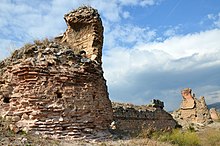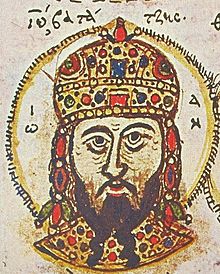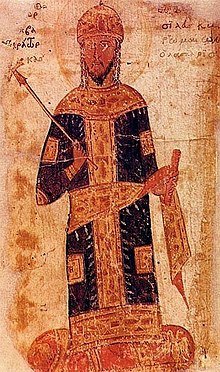使用者:Dkzzl/呂基亞與潘菲利亞
| 狄奧多爾二世·杜卡斯·拉斯卡里斯 Θεόδωρος Δούκας Λάσκαρις | |
|---|---|
| 羅馬人的皇帝與獨裁者 | |
 狄奧多爾二世的肖像(來自一份15世紀的手抄本,其內容是約翰·佐納拉斯的《歷史摘錄》) | |
| 尼西亞皇帝 自稱流亡在外的拜占庭皇帝 | |
| 統治 | 1254年11月3日 – 1258年8月16日 |
| 前任 | 約翰三世 |
| 繼任 | 約翰四世 |
| 出生 | 1221或1222年 尼西亞 (今土耳其布爾薩省伊茲尼克) |
| 逝世 | 1258年8月16日 馬格內西亞 (今土耳其艾登省特勤) |
| 配偶 | 保加利亞的埃萊娜·阿森尼娜 |
| 子嗣 更多 | 伊琳娜·杜卡伊娜·拉斯卡里娜 優多克西阿·拉斯卡里娜 約翰四世 |
| 王朝 | 拉斯卡里斯家族(母系) 瓦塔采斯家族(父系) |
| 父親 | 約翰三世·杜卡斯·瓦塔采斯 |
| 母親 | 伊琳娜·拉斯卡里娜 |
狄奧多爾二世·杜卡斯·拉斯卡里斯(希臘語:Θεόδωρος Δούκας Λάσκαρις,羅馬化:Theodōros Doukas Laskaris;1221或1222年 -1258年8月16日)是1254-1258年間在位的尼西亞皇帝。他是皇帝約翰三世與皇后伊琳娜·拉斯卡里娜的獨子,他的母親則是在1204年第四次十字軍攻陷君士坦丁堡後,在小亞細亞創立尼西亞帝國的皇帝狄奧多爾一世之長女。狄奧多爾二世從小接受兩位學者尼基弗魯斯·弗萊米澤斯與喬治·阿克羅波利特斯的精心教導,並與一些年輕知識分子建立友誼,與出身低微的喬治·穆扎隆關係最好。狄奧多爾自年輕時就開始撰寫神學、歷史、哲學主題的論文。
1235年,皇帝約翰三世安排他與保加利亞公主埃萊娜·阿森尼娜結婚,並與她的父親伊凡·阿森二世結成同盟以共同對付君士坦丁堡的拉丁帝國。狄奧多爾自稱婚姻幸福,這對夫婦生育了五個或六個孩子。1241年後,由於父親經常在巴爾幹半島作戰,狄奧多爾擔任他在小亞細亞的副手,1242年左右,他成為父親的共治者,但並未被加冕為共治皇帝。這段時期,他與幾個大貴族,尤其是狄奧多爾·菲萊斯與米海爾·巴列奧略的關係變得緊張。
1254年11月4日,狄奧多爾繼承了父親的皇位。他貶斥了許多出身貴族的官員與將領,代以忠誠的友人,其中許多人都出身不高。他與魯姆蘇丹凱考斯二世結成同盟,共同防禦蒙古帝國。他還擊退了保加利亞對馬其頓、色雷斯的入侵,並迫使伊庇魯斯的米海爾二世·科穆寧·杜卡斯將都拉齊翁及亞得里亞海沿岸地區割給尼西亞。他還改革了軍隊,更多地自小亞細亞的原住農民中招募新兵。後來伊庇魯斯的米海爾二世與塞爾維亞國王斯特凡·烏羅什一世、西西里國王曼弗雷迪締結了對抗尼西亞的同盟,1257年的戰鬥中,狄奧多爾的新將領們無力抵抗他們的聯合進攻。與此同時,狄奧多爾病重,在他生命的最後幾個月內都難以參與國家事務。他可能死於癌症或慢性癲癇,臨死前,他任命喬治·穆扎隆為他未成年的兒子約翰四世的攝政,但十天之後,喬治被一群貴族謀害,米海爾·巴列奧略接任攝政,最終篡位自立。
少年生活
[編輯]童年
[編輯]1221年末或1222年初,狄奧多爾在尼西亞城內的皇宮中呱呱墜地,他的父母是皇帝約翰三世·杜卡斯·瓦塔采斯與皇后伊琳娜·拉斯卡里娜[1]。伊琳娜則是尼西亞帝國的創立者狄奧多爾一世·拉斯卡里斯的長女[1]。尼西亞帝國是拜占庭帝國的繼承國,創立於1204年西歐人(「拉丁人」)的第四次十字軍攻陷君士坦丁堡之後[2][3]。約翰三世是伊琳娜的第三任丈夫,出身於一個與科穆寧家族、安格洛斯家族有親戚關係的貴族家族。與伊琳娜結婚後,他成為「國庫衛隊長官(βεστιαρῖται,一支禁衛軍的首領)」,此時伊琳娜的兩個弟弟都已早逝,但狄奧多爾一世並沒有正式指定約翰為他的繼承人,他可能期待他的第三任妻子拉丁人庫特奈的瑪利亞能給他生個兒子,但最終二人沒能生育[4]。1221年11月,狄奧多爾一世去世,約翰三世面臨着爭位者,他於1223-1224年的冬季在波伊馬內農戰役擊敗的妻子的的兩個兄弟伊薩克與阿萊克修斯與他們的拉丁人盟軍,開始了收復被拉丁人占領的拜占庭帝國小亞細亞領土的進程[5]。
狄奧多爾是父母的獨子,他的母親在生下他後因騎馬出現意外而失去了生育能力,他採用了母親的族姓[6]。他自稱「被按養育皇室子女的慣常方式養大」,可能指的是他在皇宮的女性區域長大、為奢華圍繞。他的童年十分快樂,而且父親也「經常給他最大的安慰」,他還曾回憶起當他的教師指責他的惡行時,他的父母並沒有懲罰他[7]。
教育
[編輯]
如果狄奧多爾的像其他貴族子弟一樣在慣常的年齡開始學習讀寫,那麼他就是於1228年開始接受啟蒙教師的教育。作為教育的一部分,他開始背誦《聖經》中的段落並每天祈禱三次,直到生命的盡頭,他都可以不看書本而直接引用《詩篇》和耶穌的各種比喻[8]。1230年,狄奧多爾開始接受第二層次的教育,他很討厭他的「王子導師(βαΐουλος)」,在自己的作品中稱他「非常愛嘮叨」,但沒有記下他的名字。在這一階段,他學習語法(古典時代的阿提卡希臘語語法)、詩歌、修辭、邏輯、算術、天文、幾何與音樂,總共學了三年。語法方面的學習激發了他對多義詞與詞源學的終身興趣,他還着迷於德摩斯梯尼和塔爾蘇斯的赫爾墨格內斯的演說,還高度推崇神學家聖額我略·納齊安。他的導師嘲諷他過於「哲學化」,敦促他多花時間研究軍事和外交。學習之餘,他還熱衷於打獵與「齊卡尼翁(τζυκάνιον,即馬球)」,騎術十分精湛[9]。
克洛科特尼察戰役後不久,狄奧多爾的父親開始計劃讓他與保加利亞沙皇伊凡·阿森二世之女公主埃萊娜結婚;這場戰役中,狄奧多爾未來的岳父擊敗並俘獲了塞薩洛尼基皇帝、伊庇魯斯統治者狄奧多爾·科穆寧·杜卡斯,削弱了伊庇魯斯-塞薩洛尼基這一同樣試圖恢復拜占庭帝國的政權、尼西亞帝國在西部的競爭對手,保加利亞成為巴爾幹半島的霸主[10]。1235年,狄奧多爾與埃萊娜結婚,他們的父親則締結了對抗君士坦丁堡的拉丁帝國的同盟,並於同年派軍共同圍攻君士坦丁堡,但沒能攻下。1237年,伊凡·阿森的態度發生180度轉變,轉而與拉丁人結盟,共同抵制尼西亞帝國在色雷斯的擴張,但同年年底又恢復了與尼西亞的聯盟。岳父的這一系列舉措讓狄奧多爾覺得不能完全信任保加利亞——這個看法伴隨了他一生[11]。
狄奧多爾後來請到了當時最有名的學者之一——時任以弗所一所修道院院長(ἡγούμενος)的尼基弗魯斯·弗萊米澤斯擔任他的老師,為他講授哲學。狄奧多爾的哲學課在他前往父親在尼姆菲翁(今凱末爾帕夏)附近的冬季行宮時進行。尼基弗魯斯對亞里士多德主義充滿熱情,對狄奧多爾產生了很大影響,後者在自己的著作中經常提及亞里士多德提出的概念,如「潛能與現實」。13世紀40年代初,有學生指控尼基弗魯斯侵吞公款,雖然狄奧多爾的父親介入,使他不必遭受牢獄之災,但他也從此放棄了教學,此後狄奧多爾仍繼續定期拜訪他並與他保持通信。出生於君士坦丁堡,並曾親身經歷拉丁人的統治的年輕學者喬治·阿克羅波利特斯取代了他,成為狄奧多爾的新任首席教師,並指導狄奧多爾完成了邏輯與數學教育[3][12]。
1239年後半年,狄奧多爾的母親去世[13]。1340年夏末,他的父親約翰三世與神聖羅馬皇帝腓特烈二世年僅十歲左右的私生女康斯坦扎(婚後改名安娜)訂婚。但約翰三世卻愛上了未來新娘的意大利侍女馬爾凱西娜(Marchesina),還給予她穿紫色(皇室的代表色)鞋子、用紫色飾物裝點馬具這些皇帝的近親才有的待遇[14]。
青年
[編輯]初次承擔管理任務
[編輯]
如果約翰三世遵循之前的先例,狄奧多爾會在還是個孩子的時候就被宣布為父親的共治君主。記述發生於1235-1237年及1242年的事件時,狄奧多爾的老師喬治·阿克羅波利特斯在他的歷史著作中提及了狄奧多爾的共治皇帝地位;狄奧多爾也在書信中自1242年左右之後自稱皇帝。但尼基弗魯斯·格雷戈拉斯、喬治·帕希梅萊斯這兩位後代的拜占庭史家卻否認他的共治皇帝地位,一種比較合理的解釋是,他在父親的有生之年內並未被加冕[15]。狄奧多爾的權力並不小,他可以授予地產與薪酬,並干涉司法糾紛,他曾應尼基弗魯斯·弗萊米澤斯的請願書,要求以弗所都主教將據說是非法購買的一片土地還給弗萊米澤斯的修道院。父親在外時,他還曾主持重臣會議,並為空缺的教會職位提出了候任者[16]。
1241年5月,約翰三世再次嘗試圍攻君士坦丁堡,但很快意識到他還無法將其收復,於是他開啟了和平談判,並讓狄奧多爾隨他會見拉丁人的使者。6月24日,雙方簽訂了為期兩年的和約;同月,保加利亞的伊凡·阿森二世去世,削弱了保加利亞的力量。1241年末,約翰三世又對保加利亞的盟友伊庇魯斯發起進攻,率軍出發前,他命狄奧多爾代他管理小亞細亞事務。狄奧多爾遵循外祖父和父親的做法,帶着宮廷人員巡迴各地,訪問了安納托利亞的許多城鎮與村莊[17]。
這時,蒙古將領拜住率軍自東面侵攻尼西亞的鄰國羅姆蘇丹國,攻占了埃爾祖魯姆。狄奧多爾通知了他正在圍攻塞薩洛尼基的父親,但約翰三世選擇不放棄進攻,他的堅持得到了回報,塞薩洛尼基的統治者約翰·科穆寧·杜卡斯放棄了自稱的皇帝頭銜,接受了約翰三世賜予的「專制君主」銜。1243年,蒙古人再次進攻羅姆蘇丹國,並於6月26日在克塞山戰役中擊潰了蘇丹凱霍斯魯二世的軍隊。此後,塞爾柱人被迫向蒙古人繳納年貢,尼西亞帝國成為整個安納托利亞唯一一個保持完全獨立的國家,但對蒙古人入侵的恐懼也成為影響尼西亞外交政策的一大因素[18][19]。
1246年,約翰三世再次率軍進攻色雷斯,繼續將小亞細亞留給狄奧多爾管理。這次遠征中,約翰三世先是奪取了塞雷,之後塞薩洛尼基的上層市民不願承受又一場長期的圍城戰,於是打開了城市的大門,自願向他投降,之後多數馬其頓城鎮紛紛效仿,尼西亞的領土幾乎擴大了一倍[20][21]。
夥伴
[編輯]狄奧多爾與一群年輕的知識分子建立了親密的友誼,他們都出生於拉丁人攻陷君士坦丁堡之後,不像他們的父輩,所謂「被羞辱的一代(普世牧首日耳曼努斯二世語)」經歷了被迫流亡的驚愕。他的朋友們的陪伴幫助他度過了一段可能由焦慮於承擔政治責任而引起的憂鬱時期。他最親近的朋友是他的童年玩伴喬治·穆扎隆,根據尼基弗魯斯·弗萊米澤斯的說法,穆扎隆三兄弟——喬治與他的兄弟狄奧多爾、安德洛尼卡都「出身低微」,但他們都有歌唱與音樂的天賦。狄奧多爾的其他密友的出身則多與高階世俗及教會官員有關,如約瑟夫·美索不達米特斯(Joseph Mesopotamites)、孔斯塔斯·阿吉歐塞歐多里特斯(Konstas Hagiotheodorites)[22]。
狄奧多爾經常取笑主教們的自我誇大、蠻族般的語言風格以及因無知造成的異端言論,甚至嘲笑他們的外表。但也有很多人對他發表了嘲諷言論,他的同學們在哲學討論中取笑他的辯論風格,但貴族與教士們的批評則更加危險:以弗所的都主教尼基弗魯斯譴責他犯了驕傲的罪,還不遵從禁食的規定;一位將領卡洛塞托斯(Kalothetos)對他發表了不敬的評論;他與塞薩洛尼基的總督狄奧多爾·菲萊斯關係十分緊張,後者散發了宣稱狄奧多爾與某位女子有染的謗詩,狄奧多爾則指責他為殺害友人特里比德斯(Tribides)的幕後黑手(不過特里比德斯的死也表明,狄奧多爾在他父親在世時就已能將自己的親信派到新征服的歐洲領土)。菲萊斯的指責也傳到了狄奧多爾的老師尼基弗魯斯·弗萊米澤斯的耳朵里,他顯然不會容忍性方面的越軌。1248年左右,弗萊米澤斯拒絕讓約翰三世的情婦馬爾凱西娜(Marchesina)及其隨從進入他在以弗所的修道院,他還為狄奧多爾及他的父親寫了一本指導君王的書,題名《論王道》(Βασιλικὸς ἀνδριάς),告誡他們不要好色、浪費公共資金。狄奧多爾無法說服老師這是一場誣陷[23]。
走向單獨統治
[編輯]約翰三世準備再次攻擊君士坦丁堡,但伊庇魯斯的統治者米海爾二世·科穆寧·杜卡斯於1252年春季進犯尼西亞在馬其頓的領土,約翰三世再次親自率軍遠征,將小亞細亞託付給狄奧多爾,最終迫使米海爾撤回伊庇魯斯。但在此期間,狄奧多爾的妻子埃萊娜於8月末突然去世,狄奧多爾為妻子服喪的時間超過了慣例的四十天,只是在父親的命令下,他才停止禁食、不再穿黑衣。妻子的死加劇了他的憂鬱,他隱居在宮中,致力於哲學研究與寫作,直到1253年才恢復對小亞細亞城鎮的定期訪問[24][25]。
1253年初,神聖羅馬皇帝腓特烈二世的兒子與繼承人康拉德迫使父親的情婦比安卡·藍齊亞的親屬們流亡,他們來到尼西亞,向比安卡的女兒,尼西亞皇后安娜(原名康斯坦扎)尋求庇護。但當時約翰三世在色雷斯,狄奧多爾接待了這批人。之後康拉德又回心轉意,派藍齊亞家族的姻親、博學的霍恩堡的貝特霍爾德(Berthold of Hohenburg)到尼西亞與他們協商。等待父親自色雷斯歸來時,狄奧多爾與貝特霍爾德進行了哲學討論,此時西歐對於研究古希臘哲學也越來越有興趣,貝特霍爾德還向狄奧多爾索要古希臘哲學書籍。這一請求也加強了狄奧多爾對古希臘遺產的自豪感,他還決定出版自己的作品[26]。
1253年冬天,約翰三世回到了尼西亞,1254年初,他突然病倒,此後一直沒有康復。他的疾病使狄奧多爾成為帝國的實際統治者,但這並沒有讓他改變出版自己作品的計劃。蒙古人將再次入侵小亞細亞的消息傳來時,他的父親還活着[27]。
統治
[編輯]登位
[編輯]1254年11月4日,約翰三世在尼西亞去世,留給狄奧多爾一個強盛的帝國[3]。狄奧多爾被承認為皇帝,但由於普世牧首之位暫時空缺,沒有立即加冕。狄奧多爾的老師喬治·阿克羅波利特斯在約翰三世的葬禮上致辭,表示希望狄奧多爾能帶領尼西亞帝國驅逐君士坦丁堡的拉丁人,將他比作《出埃及記》中引導以色列人的「火柱」[28]。 但狄奧多爾實際並沒有冒險進攻君士坦丁堡,因為他的帝國為敵對勢力所環繞[29]。
狄奧多爾禁止他父親的遺孀安娜-康斯坦扎返回故鄉西西里,這激怒了她的兄弟,剛剛成為西西里王國實際統治者的曼弗雷迪[30]。狄奧多爾與羅姆蘇丹凱考斯二世在非拉鐵非會面,達成了防禦蒙古人的同盟。凱考斯雖然承認蒙古人的宗主權,但他拒絕前往蒙哥汗的宮廷向他表示臣服[31][32]。
狄奧多爾想任命他的老師弗萊米澤斯為新任牧首,但被他拒絕了;之後他提名一位出身貴族的隱修士阿爾塞尼歐斯·奧托雷阿諾斯,後者接受,於是在1254年聖誕節(根據學術界的共識),新任牧首膏立新帝並為其加冕。圍繞這位牧首的廢立問題,教會內部還於1265-1310間爆發了內部爭執,即所謂「阿爾塞派分裂」[33]。這位牧首一直是狄奧多爾的忠實支持者,並服從他的指令[34]。
狄奧多爾不信任貴族,1254年12月寫給喬治·穆扎隆的信中,他寫到「禁忌的桃色事件與非常不公正的陰謀」,但沒有說明是誰在反對他。學者邁克爾·安戈爾德提出,神聖羅馬皇帝腓特烈二世實行的類似政策可能啟發狄奧多爾「對他手下的貴族採取更為專制的態度」[35]。狄奧多爾任命喬治·穆扎隆為「大統帥(μέγας δομέστικος)」,即野戰軍總司令,並任命喬治的兄弟安德洛尼卡為「首要國庫衛隊長官(πρωτοβεστιαρίτης)」,即皇宮衛隊長官。他還起用了其他出身一般的將領,如君士坦丁·馬爾加里特斯,還重新任用那些在他父親時被忽視的貴族,如他召回了被流放的他外祖父老皇帝狄奧多爾一世的兄弟米海爾、曼努埃爾,並讓曾叛亂的內斯同戈斯(Nestongos)家族的兩個成員:喬治與伊薩克成為將領。這一系列任命冒犯了大多數貴族[36]。
與保加利亞的戰爭
[編輯]
約翰三世死後,年輕的保加利亞沙皇米海爾二世·阿森想趁機收復1241年前保加利亞一度占有的領土,1254年12月或1255年1月,米海爾率軍入侵馬其頓與色雷斯[6][30][37]。尼西亞帝國在當地各要地的駐軍普遍不多,當地的保加利亞人平民也支持敵軍[37][38]。保加利亞軍迅速奪取了色雷斯的多數堡壘,兩座馬其頓城市韋萊斯與斯科普里也宣布投降。倉促召集的軍事會議決定採用喬治·穆扎隆提出的立即反擊的戰略,狄奧多爾決定親自統帥軍隊,並於1255年2月命穆扎隆暫時管理小亞細亞事務。敵人沒有預料到他的反擊,撤出色雷斯,於是他命將領阿萊克修斯·斯特拉特戈普羅斯、季米特里俄斯·托爾尼克斯(Demetrios Tornikes)追擊保加利亞軍隊。這兩位將領率軍穿越了羅多彼山脈的隘口,但一直害怕被伏擊,某次偶然聽到牧羊人、牧豬人吹起號角,他們就陷入了恐慌,拋下了全部輜重。狄奧多爾為此感到震怒,命令他們迅速回到他在阿德里安堡的大本營,但二人都不從命[39][40]。
一名為尼西亞帝國效力的保加利亞叛徒德拉戈塔斯(Dragotas)於夏天再次轉換陣營,於夏季開始圍攻梅爾尼克。狄奧多爾聞訊匆忙離開阿德里安堡,帶兵前往援救,保加利亞軍在魯佩爾山口為他設下埋伏,但狄奧多爾沒有上當,就在他到達梅爾尼克之前,德拉戈塔斯放棄了包圍。之後狄奧多爾前往塞薩洛尼基,罷免了當地的總督,與他有舊仇的狄奧多爾·菲萊斯,他還關閉了當地的鑄幣廠,因為他希望將鑄幣權統一收歸小亞細亞的中央政府,並在赫勒斯滂海峽亞洲一側的阿斯特里齊翁(Astritzion)建立新的國庫。隨後狄奧多爾攻入馬其頓,迫使韋萊斯的保加利亞駐軍投降,但旱災使他無法繼續在本就乾旱的奧維切平原作戰,於是他前往塞雷,在那裡確認了馬其頓諸城鎮的財政特權,他還下令逮捕奧赫里德都主教君士坦丁·卡瓦斯拉斯,因為他認為後者是伊庇魯斯的米海爾二世的忠實支持者[41]。
1255年晚秋,蒙古人入侵小亞細亞的傳言迫使狄奧多爾離開馬其頓,但很快傳言被證明為假,於是他轉而準備進攻保加利亞的采皮納要塞,但他的軍隊無法翻越狹窄而寒冷的山地隘口,於是他放棄作戰,於年底回到了安納托利亞。他為他的知己們帶來了榮譽與禮物:任命君士坦丁·馬爾加里特斯、曼努埃爾·拉斯卡里斯指揮色雷斯軍隊,並責成喬治·穆扎隆進行軍事改革。他還下令懲罰幾位古老貴族家庭的成員::君士坦丁·斯特拉特戈普羅斯、狄奧多爾·菲萊斯被瞽目;阿萊克修斯·斯特拉特戈普羅斯與阿萊克修斯·拉烏爾的四個兒子被囚禁;狄奧多爾的遠房表弟米海爾·巴列奧略則因害怕被囚禁而逃到塞爾柱人處。狄奧多爾還運用皇帝控制貴族婚姻的權力,迫使貴族家族與他出身低微的寵臣聯姻,喬治·穆扎隆迎娶了米海爾·巴列奧略的侄女狄奧多拉·拉烏爾萊娜,安德洛尼卡·穆扎隆則與阿萊克修斯·拉烏爾的女兒結婚[42]。
1256年4月或5月,狄奧多爾決定恢復與羅馬的教會聯合談判,並遣使教皇亞歷山大四世。一直以來,對「和子說」的不同看法是正教會與天主教會分裂的重要原因。正教會神學堅持認為「聖靈由父而出」,而天主教會認為「聖靈由父和子而出」。Theodore commissioned Blemmydes to summarize the Orthodox position. Blemmydes adopted a conciliatory approach, concluding that a statement about the procession of the Holy Spirit from the Father through the Son was fully in conformity with the Bible and the Church Fathers' works. Theodore did not accept his tutor's view and insisted on the traditional Orthodox doctrine.[43]
Michael II of Bulgaria dispatched Cuman raiders to plunder Thrace early in 1256. Although Theodore had instructed Laskaris and Margarites to adopt a defensive strategy, they pursued the Cumans, but the invaders inflicted a heavy defeat on their troops. Theodore assembled a new army, partially mustered among the Anatolian peasantry, and crossed the Hellespont. He sent troops, including Cuman horsemen in his service, against the invaders and they routed the enemy forces in two battles in Thrace.[44] He entered into peace negotiations with Michael II with the mediation of Rostislav Mikhailovich, Duke of Macsó. Michael II had recently married Rostislav's daughter and Rostislav's wife, Anna of Hungary, was Theodore's cousin. Rostislav came to Thrace to reach an agreement with Theodore. Akropolites drafted a treaty about the restoration of the prewar boundaries between Nicaea and Bulgaria. Rostislav accepted it and signed the peace treaty on Michael II's behalf on 29 June. The treaty prescribed that Michael II cede Tzepaina to the Nicaeans, but the Bulgarian garrison was not withdrawn immediately from the fortress. Theodore became convinced that Rostislav had deceived him and ordered the public whipping of Akropolites. His act proved imprudent, because the Bulgarians ceded the fortress in early September. Theodore sent George Mouzalon to Akropolites to seek a reconciliation.[37][45][46]
The peace treaty aroused much indignation in Bulgaria, enabling Michael II's cousin, Kaliman, to stage a plot and dethrone the Tzar. Kaliman seized the throne, but he never gained the support of the army. After he fell victim to a new plot, Rostislav Mikhailovich and Michael II's brother-in-law, Mitso, laid claim to the throne. Most boyars (noblemen) preferred a third candidate, one of their number, Konstantin Tih, although he was not related to the ruling Asen dynasty.[47][48][49]
擴張
[編輯]Theodore's war against Bulgaria brought about a rapprochement between Epirus and Serbia. Michael II of Epirus made a formal alliance with Stefan Uroš I, King of Serbia. He also sent gifts to the Albanian chiefs who had acknowledged Nicaean suzerainty to gain their support. Theodore's daughter, Maria, and Michael II's son and heir, Nikephoros, had been engaged during Vatatzes' reign. After making peace with the Bulgarians, Theodore ordered Michael II to send Nikephoros to Thessalonica to wed Maria. Nikephoros was accompanied by his mother, Theodora Petraliphaina. Theodore took her into custody, only allowing her to return to Epirus after Michael II ceded Servia and Dyrrachium to him. The possession of the two towns secured the Nicaean control of the Via Egnatia, but Michael II remained hostile to Theodore.[6][50]
Theodore received the papal legate, Bishop Constantine of Orvieto, in Thessalonica. Their negotiations proved fruitless, because the legate's authorization was limited and Theodore was unwilling to make concessions for the church union. He also preserved the right to convoke the Orthodox bishops to a synod to discuss the conditions of the union. Theodore maintained a correspondence with the Holy See, but he did not initiate new negotiations with it.[51]
The Mongols invaded Asia Minor and defeated Kaykaus II on 14 October 1256. Theodore hurried back to Anatolia to oversee the preparations for the defense. Kaykaus sought asylum in Nicaea and the Mongols installed his brother, Kilij Arslan IV, as the new sultan of Rum. Theodore assembled his troops on the plains near Magnesia. The Mongol ruler of Persia, the Ilkhan Hülagü, sent a delegation to Theodore to begin negotiations about Kaykaus' future. Hülegü agreed to withdraw his army from Rum and ordered the division of the sultanate between Kaykaus and Kilij Arslan in the spring of 1257. Before leaving for Rum, Kaykaus ceded four fortresses in the valley of the river Lycus to Nicaea in return for a contingent of 300 auxiliary troops.[52][53] His achievements made Theodore self-confident. He proudly stated that his empire included territories as far as Dyrrachium on the Adriatic Sea and Cape Karambis on the Black Sea. His success during the war against Bulgaria had convinced him he should recruit soldiers from among Anatolian peasants. In a letter to Blemmydes, he stated that the native "Hellenes" were more reliable than foreign mercenaries.[54][55]
疾病與死亡
[編輯]
1257年11月,狄奧多爾病重。當時年僅十六歲的史家喬治·帕希梅萊斯稱他患的是癲癇,並記載他經常失去知覺,倒在地上;他還認為狄奧多爾不尋常的用人政策與促使貴庶家族聯姻結盟的舉措是由他的疾病引起的;喬治·阿克羅波利特斯只是記載狄奧多爾的體重極度降低,身體看起來像一具骷髏;尼基弗魯斯·弗萊米澤斯則稱狄奧多爾的疾病為「一種天災,一種奇怪的疾病」,還提到了狄奧多爾的憂鬱症與恐懼症。狄奧多爾在自己的作品中也寫到他的手臂曾有難以忍受的疼痛與麻痹。現代疾病學者對他的病沒有一致的意見,約翰·拉斯卡拉托斯(John Lascaratos)與帕納格希歐提斯·V·齊斯(Panaghiotis V. Zis)認為帕希梅萊斯提到的癲癇是正確的,認為狄奧多爾在快三十歲時發展出了強直-陣攣性發作癲癇[56]。學者唐納德·尼科爾認為狄奧多爾的疾病「使他成為自己情緒的犧牲品,為了緩解焦慮,他變得專斷而固執」[34]。但醫學史家吉奧爾吉奧斯·馬克里斯(Georgios Makris)在其1995年發表的拜占庭帝國癲癇研究中認為狄奧多爾得的並不是癲癇。學者迪米特爾·安格洛夫(Dimiter Angelov)也不認可帕希梅萊斯的說法,認為狄奧多爾最可能是得了腦癌、脊柱腫瘤或肺癌[57]。
生病使得狄奧多爾無法親自統帥軍隊,而他的大多出身低微、由他提拔的將領們無力阻止伊庇魯斯、阿爾巴尼亞人、塞爾維亞人劫掠馬其頓的尼西亞領地。 Stefan Uroš I defeated the Nicaean troops near Prilep. Michael II's sister-in-law, Maria Petraliphaina, entered into a correspondence with Theodore's commander, Constantine Chabaron, making him believe that she was eager to marry him, but Chabaron was captured during their meeting. Theodore's newly assembled army of Anatolian peasants was routed at Edessa. Michael Palaiologos, who had been allowed to return from his exile, lead a new army to Macedonia. He defeated the Epirotes, but Theodore ordered him to return instead of marching to Prilep. Palaiologos' withdrawal enabled Michael II to seize Prilep and capture Akropolites, who was its governor. Michael II was planning to launch an attack against Thessalonica, but Manfred of Sicily renewed his predecessors' claim to Byzantine territories and invaded Epirus from the west. Michael II, who did not want to abandon his plan, concluded an alliance with Manfred who expelled the Nicaean garrisons from Dyrrachium and other fortresses on the Adriatic by the end of February 1258.[30][58][59]
Konstantin Tih of Bulgaria repudiated his first wife and sued for the hand of Theodore's eldest daughter, Irene. He knew that his marriage to Irene, who was Tzar Ivan Asen II's granddaughter, could strengthen his claim to rule. Theodore wanted to confirm his peace treaty with Bulgaria and accepted Konstantin Tih's offer. Irene went to Bulgaria to marry Konstantin Tih.[60][61]
Theodore rarely left his palace at Magnesia during the last months of his life. He was convinced that sorcery caused his illness and accused his courtiers of casting spells on him, sending many of them for trial. Michael Palaiologos's sister, Maria-Martha, was the most famous victim of Theodore's paranoia. Theodore had forced her daughter, Theodora, to marry the elderly Basil Kaballarios, but the marriage was never consummated. After Kaballarios had attributed his impotence to his mother-in-law's spells, Theodore had her put into a sack filled with cats that tore her flesh. She was only released because Theodore suddenly panicked, fearing her spells. Also fearing her brother's revenge, Theodore had Michael Palaiologos imprisoned on charges of poisoning, but soon set him free.[45] Theodore named his seven-year-old son, John, as his sole heir, appointing George Mouzalon regent until John came of age. He became a monk, but he kept his baptismal name. He summarized his sins in a treatise and asked the patriarchal synod to grant him absolution. He died in the imperial palace at Magnesia on 16 August 1258.[62] He was buried next to his father in the Sosandra monastery on Mount Sipylus. His grave and the monastery were destroyed after the Turkish conquest of the region in the 14th century.[63]
The aristocrats had taken an oath of loyalty to Mouzalon at Theodore's deathbed, but they soon began conspiring against him. In ten days, Mouzalon was murdered, and Michael Palaiologos assumed the regency for the child-emperor, John IV Laskaris. Palaiologos convinced the aristocrats that an empire ruled by a boy could not resist enemy attacks, and he was proclaimed co-emperor as Michael VIII before the end of the year. When Michael VIII and John IV were crowned together early in 1259, the Patriarch put the crown first on Michael VIII's head. After concluding an agreement with Genoa against the Latin Empire, he dispatched Alexios Strategopoulos to spy on the defences of Constantinople. Taking advantage of the absence of the bulk of the Latin army, Strategopoulos seized Constantinople by a surprise attack on 25 July 1261. Michael VIII was crowned for the second time, alone, in the Hagia Sophia.[59][47][64] The child John IV was blinded on 25 December 1261, which prevented him from ruling.[65] In order to emphasize that the Laskaris family had lost their imperial status, Michael VIII married off his three sisters to minor Italian and Bulgarian noblemen.[66]
學術成就
[編輯]A man of letters devoted to philosophical and theological studies, Theodore transformed his court into a center for renowned scholars shortly after his ascension to the throne.[3] He ordered that books that he and his father had collected in urban libraries be available to all who wanted to read them.[34][67] He began to write treatises on philosophical, theological and historical subjects already during his father's lifetime, but he decided to prepare manuscript editions of his works only after his meeting with Berthold of Hohenburg in 1253. His works were collected in four codices, but only three survived.[68]
Theodore's Satire of the Tutor, written most likely in 1240, is his earliest extant work. The satire is dedicated to his principal tutor, portraying him as an under-educated and rude man, who learned magic while staying in Bulgaria. He also wrote encomia in praise of the citizens of Nicaea, his father and Akropolites. Theodore's theological works—including his First Oration against the Latins, or, on the Procession of the Holy Spirit, and his treatise On the Trinity—demonstrate his adherence to Orthodox theology.[69] Theodore's Great Supplicatory Canon to Our Lady, a hymn to the Virgin Mary, is his best known work. He composed it just months before his death and it is still sung in Orthodox ceremonies.[70]
家庭
[編輯]狄奧多爾與埃琳娜在結婚時都沒有達到法定的最低結婚年齡——男性十四歲、女性十二歲,但這樣的早婚在尼西亞的貴族與平民中並不罕見。他的妻子1224年出生,父母是保加利亞沙皇伊凡·阿森二世與匈牙利的瑪利亞。兩人的結婚典禮於1235年初在蘭普薩庫斯舉行。兩年後,伊凡·阿森二世準備進攻尼西亞在色雷斯的領地,於是強迫埃琳娜返回保加利亞,但同年末兩國恢復和平後,她又回到狄奧多爾身邊。 Years later, Theodore described Elena as the flower of his youth and stated that their "bond of incomparable love" made them "happier than all people". Her sudden death in the spring or summer of 1252 plunged Theodore into grief. She gave birth to four or five daughters, and one son.[71] Their children were:
- 伊琳娜,與保加利亞貴族、沙皇君士坦丁·提赫(1257-1277年在位)結婚,弟弟被篡位後成為米海爾八世的死敵,直到她於約1270年去世[72]。
- 瑪利亞,與伊庇魯斯統治者尼基弗魯斯一世結婚,死於1257-1265年之間[73][74]。
- 狄奧多拉, was married off by Michael VIII to a Moreot nobleman, Maïos Débélikourtos, according to Pachymeres and Nicephorus Gregoras. Historian Albert Failler identifies him as Matthew of Mons who held the Barony of Veligosti in the Principality of Achaea.[75]
- 優多克西阿 first married Count William-Peter of Ventimiglia, who died around 1280. Her second husband, Roger Arnau, Count of Pallars, died in 1288. The widowed Eudoxia had a love affair with the Aragonese admiral Bernat de Serria. She died in 1309.[76]
- 一個姓名未知的女兒,A Bulgarian boyar, Despot Jacob Svetoslav, married Theodore's unnamed daughter, according to Pachymeres. She may have been Theodore's illegitimate daughter, because other Byzantine historians failed to mention her.[77]
- 獨子[[約翰], survived his mutilation, but he spent the rest of his life in prison. He died around 1309.[78]
| 狄奧多爾的家系及他與其他拜占庭大族的親戚關係示意圖 | |||||||||||||||||||||||||||||||||||||||||||||||||||||||||||||||||||||||||||||||||||||||||||||||||||||||||||||||||||||||||||||||||||||||||||||||||||||||||||||||||||||||||||||||||||||||||||||||||||||||||||||||||||||||||||||||||||||||||||||||||||||||||||||||||||||||||||||||||||||||||||||||||||||||||||||||||||||||||||||||||||||||||||||||||||||||||||||||||||||||||||||||||||||||||||||||||||||||||||||||||||||||||||||||||||||||||||||||||||||||||||||||||||||||||||||||||||||||||||||||||||||||||||||||||||||||||||||||||||||||||||||||||||||||||||||||||||||||||||||||||||||||||||||||||||||||||||||||||||||||||||||||||||||||||||||||||||||||||||||||||||||||||||||||||||||||||||||||||||||||||||||||||||||||||||||||||||||||||||||||||||||||||||||||||||||||||||||||||||||||||||||||||||||||||||||||||||||||||||||||||||||||||||||||||||||||||||||||||||||||||||||||||||||||||||||||||||||||||||||||||||||||||||||||||||||||||||||||||||||||||||||||||||||||||||||||||||||||||||||||||||||||||||||||||||||||||||||||||||||||
|---|---|---|---|---|---|---|---|---|---|---|---|---|---|---|---|---|---|---|---|---|---|---|---|---|---|---|---|---|---|---|---|---|---|---|---|---|---|---|---|---|---|---|---|---|---|---|---|---|---|---|---|---|---|---|---|---|---|---|---|---|---|---|---|---|---|---|---|---|---|---|---|---|---|---|---|---|---|---|---|---|---|---|---|---|---|---|---|---|---|---|---|---|---|---|---|---|---|---|---|---|---|---|---|---|---|---|---|---|---|---|---|---|---|---|---|---|---|---|---|---|---|---|---|---|---|---|---|---|---|---|---|---|---|---|---|---|---|---|---|---|---|---|---|---|---|---|---|---|---|---|---|---|---|---|---|---|---|---|---|---|---|---|---|---|---|---|---|---|---|---|---|---|---|---|---|---|---|---|---|---|---|---|---|---|---|---|---|---|---|---|---|---|---|---|---|---|---|---|---|---|---|---|---|---|---|---|---|---|---|---|---|---|---|---|---|---|---|---|---|---|---|---|---|---|---|---|---|---|---|---|---|---|---|---|---|---|---|---|---|---|---|---|---|---|---|---|---|---|---|---|---|---|---|---|---|---|---|---|---|---|---|---|---|---|---|---|---|---|---|---|---|---|---|---|---|---|---|---|---|---|---|---|---|---|---|---|---|---|---|---|---|---|---|---|---|---|---|---|---|---|---|---|---|---|---|---|---|---|---|---|---|---|---|---|---|---|---|---|---|---|---|---|---|---|---|---|---|---|---|---|---|---|---|---|---|---|---|---|---|---|---|---|---|---|---|---|---|---|---|---|---|---|---|---|---|---|---|---|---|---|---|---|---|---|---|---|---|---|---|---|---|---|---|---|---|---|---|---|---|---|---|---|---|---|---|---|---|---|---|---|---|---|---|---|---|---|---|---|---|---|---|---|---|---|---|---|---|---|---|---|---|---|---|---|---|---|---|---|---|---|---|---|---|---|---|---|---|---|---|---|---|---|---|---|---|---|---|---|---|---|---|---|---|---|---|---|---|---|---|---|---|---|---|---|---|---|---|---|---|---|---|---|---|---|---|---|---|---|---|---|---|---|---|---|---|---|---|---|---|---|---|---|---|---|---|---|---|---|---|---|---|---|---|---|---|---|---|---|---|---|---|---|---|---|---|---|---|---|---|---|---|---|---|---|---|---|---|---|---|---|---|---|---|---|---|---|---|---|---|---|---|---|---|---|---|---|---|---|---|---|---|---|---|---|---|---|---|---|---|---|---|---|---|---|---|---|---|---|---|---|---|---|---|---|---|---|---|---|---|---|---|---|---|---|---|---|---|---|---|---|---|---|---|---|---|---|---|---|---|---|---|---|---|---|---|---|---|---|---|---|---|---|---|---|---|---|---|---|---|---|---|---|---|---|---|---|---|---|---|---|---|---|---|---|---|---|---|---|---|---|---|---|---|---|---|---|---|---|---|---|---|---|---|---|---|---|---|---|---|---|---|---|---|---|---|---|---|---|---|---|---|---|---|---|---|---|---|---|---|---|---|---|---|---|---|---|---|---|---|---|---|---|---|---|---|---|---|---|---|---|---|---|---|---|---|---|---|---|---|---|---|---|---|---|---|---|---|---|---|---|---|---|---|---|---|---|---|---|---|---|---|---|---|---|---|---|---|---|---|---|---|---|---|---|---|---|---|---|---|---|---|---|---|---|---|---|---|---|---|---|---|---|---|---|---|---|---|---|---|---|---|---|---|---|---|---|---|---|---|---|---|---|---|---|---|---|---|---|---|---|---|---|---|---|---|---|---|---|---|---|---|---|---|---|---|---|---|---|---|---|---|---|---|---|---|---|---|---|---|---|---|---|---|---|---|---|---|---|---|---|---|---|---|---|---|---|---|---|---|---|---|---|---|---|---|---|---|---|---|---|---|---|---|---|---|---|---|---|---|---|---|---|---|---|---|---|---|---|---|---|---|---|---|---|---|---|---|---|---|---|---|---|---|---|---|---|---|---|---|---|---|---|---|---|---|---|---|---|---|---|---|---|---|---|---|---|---|---|---|---|---|---|---|---|---|---|---|---|---|---|---|---|---|---|---|---|---|---|---|---|---|---|---|---|---|---|---|---|---|---|---|---|---|---|---|---|---|---|---|---|---|---|---|---|---|---|---|---|---|---|---|---|---|---|---|---|---|---|---|---|---|---|---|---|---|---|---|---|---|---|---|---|---|---|---|---|---|---|---|---|---|---|---|---|---|---|---|---|---|---|---|---|---|---|---|---|---|---|---|
| |||||||||||||||||||||||||||||||||||||||||||||||||||||||||||||||||||||||||||||||||||||||||||||||||||||||||||||||||||||||||||||||||||||||||||||||||||||||||||||||||||||||||||||||||||||||||||||||||||||||||||||||||||||||||||||||||||||||||||||||||||||||||||||||||||||||||||||||||||||||||||||||||||||||||||||||||||||||||||||||||||||||||||||||||||||||||||||||||||||||||||||||||||||||||||||||||||||||||||||||||||||||||||||||||||||||||||||||||||||||||||||||||||||||||||||||||||||||||||||||||||||||||||||||||||||||||||||||||||||||||||||||||||||||||||||||||||||||||||||||||||||||||||||||||||||||||||||||||||||||||||||||||||||||||||||||||||||||||||||||||||||||||||||||||||||||||||||||||||||||||||||||||||||||||||||||||||||||||||||||||||||||||||||||||||||||||||||||||||||||||||||||||||||||||||||||||||||||||||||||||||||||||||||||||||||||||||||||||||||||||||||||||||||||||||||||||||||||||||||||||||||||||||||||||||||||||||||||||||||||||||||||||||||||||||||||||||||||||||||||||||||||||||||||||||||||||||||||||||||||
引用
[編輯]- ^ 1.0 1.1 Angelov 2019,第57頁.
- ^ Nicol 1993,第10–11頁.
- ^ 3.0 3.1 3.2 3.3 Lascaratos & Zis 1998,第296頁.
- ^ Angelov 2019,第32–34頁.
- ^ Angelov 2019,第57–59頁.
- ^ 6.0 6.1 6.2 Treadgold 1997,第721頁.
- ^ Angelov 2019,第59–60, 257 (notes 21–22)頁.
- ^ Angelov 2019,第64–66頁.
- ^ Angelov 2019,第68–72, 75–77頁.
- ^ Angold 2017,第738頁.
- ^ Angelov 2019,第65, 73–75頁.
- ^ Angelov 2019,第79, 85, 117–118頁.
- ^ Angelov 2019,第88頁.
- ^ Angelov 2019,第90–91頁.
- ^ Angelov 2019,第61, 258 (notes 34 and 36)頁.
- ^ Angelov 2019,第98–101頁.
- ^ Angelov 2019,第92, 100頁.
- ^ Korobeinikov 2017,第720–721頁.
- ^ Angelov 2019,第92–96頁.
- ^ Fine 1994,第156–157頁.
- ^ Angelov 2019,第92, 96–97頁.
- ^ Angelov 2019,第109–118頁.
- ^ Angelov 2019,第90, 118–125頁.
- ^ Angelov 2019,第92, 128–132頁.
- ^ Fine 1994,第158頁.
- ^ Angelov 2019,第140–145頁.
- ^ Angelov 2019,第147–148頁.
- ^ Angelov 2019,第148頁.
- ^ Treadgold 1997,第730頁.
- ^ 30.0 30.1 30.2 Nicol 1993,第28頁.
- ^ Korobeinikov 2017,第721頁.
- ^ Angelov 2019,第149–150頁.
- ^ Angelov 2019,第150, 296 (note 25)頁.
- ^ 34.0 34.1 34.2 Nicol 1993,第27頁.
- ^ Angold 2017,第748頁.
- ^ Angelov 2019,第151–152頁.
- ^ 37.0 37.1 37.2 Fine 1994,第159頁.
- ^ Kanellopoulos & Lekea 2007,第56頁.
- ^ Angelov 2019,第151–154頁.
- ^ Kanellopoulos & Lekea 2007,第57–58頁.
- ^ Angelov 2019,第156–159頁.
- ^ Angelov 2019,第159–162, 169頁.
- ^ Angelov 2019,第162–163頁.
- ^ Kanellopoulos & Lekea 2007,第59–60頁.
- ^ 45.0 45.1 Lascaratos & Zis 1998,第297頁.
- ^ Angelov 2019,第164–166頁.
- ^ 47.0 47.1 Treadgold 1997,第722頁.
- ^ Angelov 2019,第166–167頁.
- ^ Fine 1994,第170–172頁.
- ^ Fine 1994,第160頁.
- ^ Angelov 2019,第168–169頁.
- ^ Korobeinikov 2017,第721–722頁.
- ^ Angelov 2019,第169–171頁.
- ^ Angelov 2019,第172–174頁.
- ^ Kanellopoulos & Lekea 2007,第68頁.
- ^ Lascaratos & Zis 1998,第297–298頁.
- ^ Angelov 2019,第381–383頁.
- ^ Angelov 2019,第175–176頁.
- ^ 59.0 59.1 Fine 1994,第161頁.
- ^ Angelov 2019,第67頁.
- ^ Fine 1994,第172頁.
- ^ ODB, p. 2039
- ^ Angelov 2019,第178–180頁.
- ^ Nicol 1993,第29–36頁.
- ^ Failler 1980,第65頁.
- ^ Nicol 1993,第44–45頁.
- ^ Angelov 2019,第106頁.
- ^ Angelov 2019,第145, 323–326, 329頁.
- ^ Angelov 2019,第70–71,329–342頁.
- ^ Kanellopoulos & Lekea 2007,第62頁.
- ^ Angelov 2019,第72–75頁.
- ^ Failler 1980,第67頁.
- ^ Failler 1980,第68頁.
- ^ Fine 1994,第169頁.
- ^ Failler 1980,第68–70頁.
- ^ Failler 1980,第70–72頁.
- ^ Failler 1980,第72–73頁.
- ^ Failler 1980,第76–77頁.
來源
[編輯]- Angelov, Dimiter. The Byzantine Hellene: The Life of Emperor Thodore Laskaris and Byzantium in the Thirteenth Century. Cambridge University Press. 2019. ISBN 978-1-108-48071-0.
- Angold, Michael. After the Fourth Crusade: the Greek rump states and the recovery of Byzantium. Shepard, Jonathan (編). The Cambridge History of the Byzantine Empire, c. 500–1492. Cambridge University Press. 2017: 731–758 [2008]. ISBN 978-0-521-83231-1.
- Failler, Albert. Chronologie et composition dans l'Histoire de Georges Pachymère [Chronology and composition in George Pachymeres' History]. Revue des études byzantines. 1980, 38: 5–103. ISSN 0771-3347 (法語).
- Fine, John Van Antwerp. The Late Medieval Balkans: A Critical Survey from the Late Twelfth Century to the Ottoman Conquest. Ann Arbor, Michigan: University of Michigan Press. 1994 [1987]. ISBN 0-472-08260-4 (英語).
- Kanellopoulos, Nicholas S.; Lekea, Joanne K. The Struggle Between the Nicean Empire and the Bulgarian State (1254–1256): Towards a Revival of Byzantine Military Tactics under Theodore II Lascaris. Rogers, Clifford J.; DeVries, Kelly; France, John (編). The Journal of Medieval Military History V. The Boydell Press. 2007: 56–69. ISBN 978-1-84383-339-0.
- Korobeinikov, D. A. Raiders and neighbours: the Turks (1040–1304). Shepard, Jonathan (編). The Cambridge History of the Byzantine Empire, c. 500–1492. Cambridge University Press. 2017: 692–727 [2008]. ISBN 978-0-521-83231-1.
- Lascaratos, John; Zis, Panaghiotis Vassilios. The epilepsy of the Emperor Theodore II Lascaris (1254–1258). Journal of Epilepsy. 1998, 11 (6): 296–300. ISSN 0896-6974. doi:10.1016/S0896-6974(98)00032-2.
- Nicol, Donald M. The Last Centuries of Byzantium, 1261–1453 Second. London: Rupert Hart-Davis Ltd. 1993. ISBN 0-246-10559-3 (英語).
- Treadgold, Warren. A History of the Byzantine State and Society. Stanford, California: Stanford University Press. 1997. ISBN 0-8047-2630-2 (英語).
延伸閱讀
[編輯]- Angold, Michael. A Byzantine Government in Exile: Government and Society Under the Laskarids of Nicaea (1204–1261). Oxford University Press. 1975. ISBN 0-19-821854-0.
- Dimiter G. Angelov, "The 'Moral Pieces' by Theodore II Laskaris", Dumbarton Oaks Papers, 65/66 (2011-2012), pp. 237–269
Dkzzl/呂基亞與潘菲利亞 Laskarid dynasty 出生於:unknown1221逝世於:16 August1258
| ||
|---|---|---|
| 統治者頭銜 | ||
| 前任者: John III Doukas Vatatzes |
Emperor of Nicaea 1254–1258 |
繼任者: John IV Doukas Laskaris |
- 13th-century Byzantine emperors
- 13th-century Byzantine writers
- 13th-century Byzantine people
- 13th-century Greek people
- 13th-century Eastern Orthodox theologians
- Emperors of Nicaea
- Laskarid dynasty
- Eastern Orthodox monarchs
- Byzantine people of the Byzantine–Bulgarian Wars
- Vatatzes family
- People with epilepsy
- 1220s births
- 1258 deaths
- Sons of Byzantine emperors
